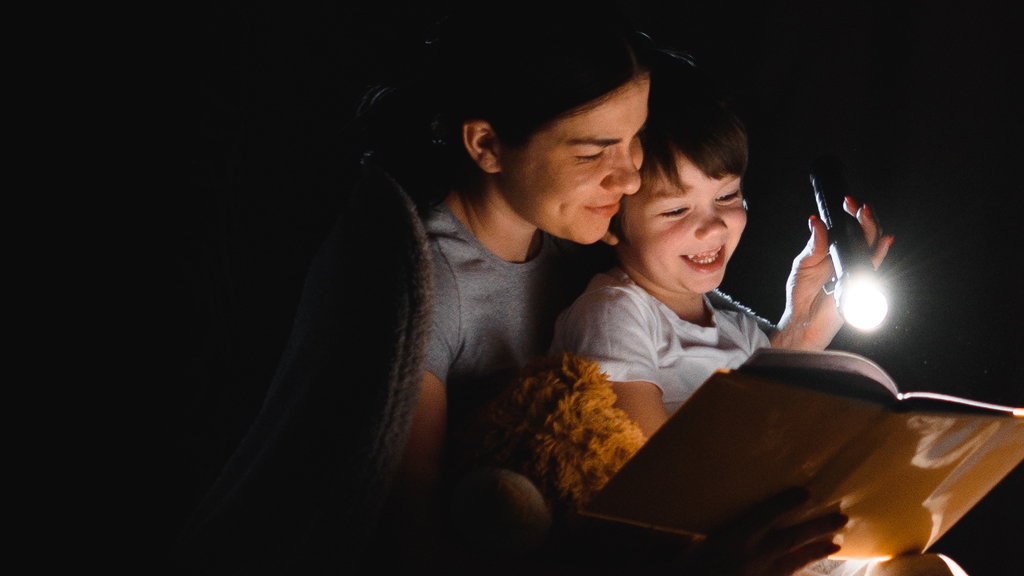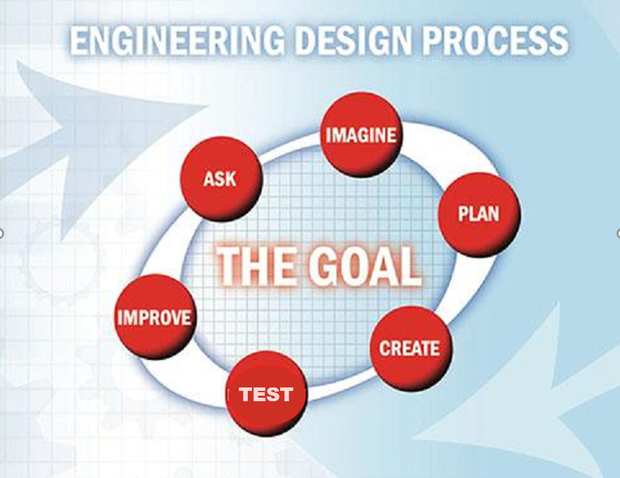Elementary | Daily Do
How Can We Make a Room as Dark as Possible?

Crosscutting Concepts Disciplinary Core Ideas Engineering Is Lesson Plan NGSS Phenomena Physical Science Science and Engineering Practices Three-Dimensional Learning Elementary Grade 1
Introduction
In today's Daily Do, How Can We Make a Room as Dark as Possible?, students engage in the engineering challenge of making a room as dark as possible for a sleeping child’s nap time. Students investigate common materials found in homes to determine which materials block or redirect light best before imagining, planning, building, and testing light-blocking solutions.

Engineering Design Process
The Engineering Design Process is a series of steps engineers use to guide them in problem solving. Engineers must ask a question; imagine a solution and research ideas and solutions that already exist; plan a design; create and test a model of the design; then take time to improve it. The graphic above is attributed to NASA’s STEM Engagement website and tools for educators (with slight modification).
Introducing the Engineering Challenge and Identifying the Problem
To introduce the engineering challenge to your student, watch the video made by elementary science teacher and NSTA member Sean Musselman, who demonstrates how his family blocks light in his child’s bedroom, before introducing the Darken the Room Challenge to your student.
Assessing Prior Knowledge
Encourage your student to share what they know (or think they know) about materials and how they affect light. Ask them to share some examples of materials they think block light better than others, and ask, “Why do you think these materials block light better than other materials?” Students may give many different reasons to explain why some materials block, or reflect, light better than others, but the goal here is not to distinguish between right vs. wrong. Rather, we want to foster discussion about the properties of these materials and what makes some materials more suitable to use in the Darken the Room Challenge than others.
Students may also draw on knowledge from previous grade levels during this discussion.
- Early elementary-grade students (K–2) may already be aware that some materials block light and that materials that block light produce a shadow.
- Late elementary-grade students may already be aware of words used to describe light blocking properties of materials, such as opaque, translucent, transparent, and reflective.
Connections to ideas and learning opportunities at previous grade levels should be encouraged. Dig deeper into your students' thoughts by asking follow-up questions such as "Can you tell me more about that?" or "How do you know that?"
Ask Phase of the Engineering Design Process
Ask students, “What is the problem we are trying to solve? What do we need to know to solve the problem?” Make sure that students ultimately understand they are working toward the shared goal of figuring out which materials block light best to know which kinds of materials to use to darken our room.
Imagine Phase of the Engineering Design Process
During the Imagine stage of the Engineering Design Process, students must brainstorm solutions and research ideas. Students have already brainstormed which materials they think will work best and which will not, but how do they know what they think is true? Tell students, “We will have to investigate the different ways we currently block light and the materials you use to complete the Darken the Room Challenge.”
Have students pair up and provide each pair with a flashlight or other portable light source (smart devices often have a flashlight feature.) Give students an opportunity to imagine how they might investigate different materials or current room darkening solutions, such as shades or shutters. Questions to ask that might facilitate conversation that lead to stronger investigations include these:
● What will you be looking for to determine if a material blocks light well or not?
● How will you collect your data as you investigate different materials?
If students are struggling to find a way to investigate, you can share this investigation video. But if students develop a sufficiently fair test to investigate materials on their own, it is encouraged that you allow them to pursue their own investigation plans. You will want to make sure they collect data as they investigate. If students do not readily prepare their own data table, or if you or time constraints limit this opportunity, consider sharing the data table provided on page four of this digital notebook.
Charge students to investigate as many materials as they can, including the materials they thought would and would not block light well, to confirm their thinking or help reveal misconceptions.
Reaching Consensus on Investigation Results
There are many ways you might transition from the brainstorm stage investigation to students making sense of the data they collected.
- Ask students to make a claim about which materials blocked light best. Students may demonstrate/recreate their investigation steps to show their process and confirm the data they collected.
- Ask students to look for any pattern in the materials that blocked light best and the materials that did not block light well. Students may notice that some loosely woven fabrics actually have holes between threads that may lead to light passing through, or that thicker materials are more likely to block all the light than thinner materials.
- Push student thinking to consider how materials that only block some light may still be useful materials when completing the Darken the Room Challenge. Materials have several different properties such as flexibility and weight that may need to be considered when planning and constructing room darkening solutions.
Plan, Create, Test, and Improve
Ask students to independently (Alone Zone) sketch a model that explains how they will use materials they determined to be effective light blockers (or reflectors!) to block out light sources identified in the first part of the Darken the Room Challenge. Remind students that they may only use materials that are currently available in the home or classroom.
If students have a difficult time starting their models, ask, "What absolutely has to be in the model (components) to explain how the room darkeners will work (sources of light; materials selected to darken the room; fasteners or other materials needed to hold room-darkening pieces in place)? How might you show the interaction between these (point to two) components? (arrows of light, lines, words). Other questions to ask that may improve student thinking around their design plan include these:
- What does that line represent? (for example, light source).
- How might you show what happens to the light after it reaches your room-darkening solution?"
- How do I know which materials are being used in this model? (key or labels)
If an opportunity to review several different models is possible, ask students to do so. You might choose to have one student explain their model to the group while the other group members note similarities and differences between the sharer's model and their own. Students can use the sentence starter, "One thing that is similar/different between your model and my model is...." Give students time to revise their models after everyone in the group has had at least one turn to share a similarity and difference.
Create, Test, and Improve Design Process
Have students work together to darken the selected room with solutions created in the vision of the design or designs shared in the planning stages of the Engineering Design Process. It is common for younger students to tinker as they create and test, so you may want to consider “controlling the environment” by asking students to wait to put their solutions in place until all solutions are ready and can be tested and compared together. Have students observe how well the room is darkened by their solutions by taking before and after photos of the rooms so that design effectiveness can be compared to the control (the room with no room-darkening solutions) and other room darkening solutions as well. If time allows, provide an opportunity for students to re-work their original designs to improve outcomes. Before students improve their designs, ask them to identify one or more parts of their solutions that worked well and did not work well. Encourage students to keep design elements that worked well while improving the parts that did not.


